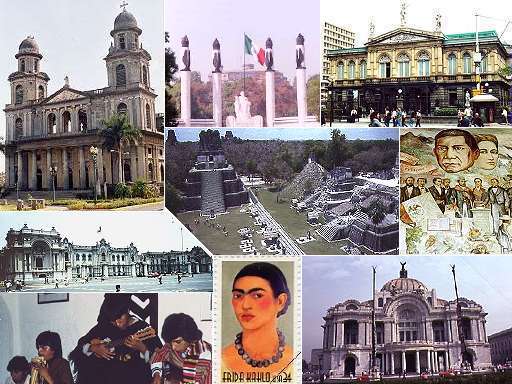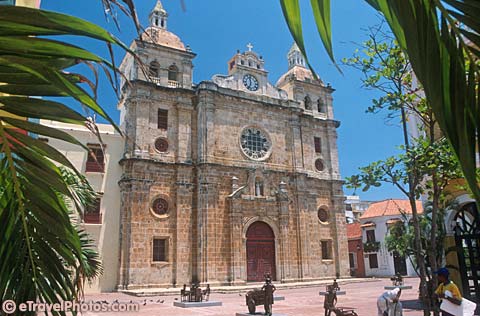Racial groups
The inhabitants of Latin America are of a variety of ancestries, ethnic groups, and races, making the region one of the most diverse in the world. The specific composition varies from country to country: many have a predominance of European-Amerindian, or Mestizo , population; in others, Amerindians are a majority; some are dominated by inhabitants of European ancestry; and some countries' populations are primarily Mulatto . Black , Asian , and Zambo (mixed Black and Amerindian) minorities are also identified regularly. Europeans/Whites are the largest single group, and along with people of part-European ancestry, they combine to make up approximately 80% of the population, or even more.
- Amerindians . The aboriginal population of Latin America, the Amerindians (native Americans), arrived thousands of years ago, during the Lithic stage . In post-Columbian times they experienced tremendous population decline, particularly in the early decades of colonization. They have since recovered in numbers, surpassing sixty million (by some estimates), though with the growth of the other groups meanwhile, they now compose a majority only in Bolivia and Guatemala , and at least a plurality in Peru . In Ecuador , Amerindians are a large minority that comprises two-fifths of the population. Mexico's 14% (alternatively 30%) is the next largest ratio, and actually the largest Amerindian population in the Americas, in absolute numbers. Most of the remaining countries have Amerindian minorities, in every case making up less than one-tenth of the respective country's population. In many countries, people of mixed Amerindian and European ancestry make up the majority of the population (Mestizo ).
- Asians . People of Asian descent number several million in Latin America. The first Asians to settle in the region were Filipino , as a result of Spain's trade involving Asia and the Americas. The majority of Asian Latin Americans are of Japanese or Chinese ancestry and reside mainly in Brazil and Peru ; there is also a growing Chinese minority in Panama . Brazil is home to perhaps two million people of Asian descent, which includes the largest ethnic Japanese community outside of Japan itself, estimated as high as 1.5 million, and circa 200,000 ethnic Chinese and 100,000 ethnic Koreans . Ethnic Koreans also number tens of thousands of individuals in Argentina and Mexico. Peru, with 1.47 million people of Asian descent, has one of the largest Chinese communities in the world, with nearly one million Peruvians being of Chinese ancestry. There is a strong ethnic-Japanese presence in Peru, where a past president and a number of politicians are of Japanese descent. The Martiniquais population includes an African-White-Indian mixed population, and an East Indian population. The Guadeloupe , an East Indian population, is estimated at 14% of the population.
- Blacks . Millions of African slaves were brought to Latin America from the sixteenth century onward, the majority of whom were sent to the Caribbean region and Brazil . Today, people identified as "Black" are most numerous in Brazil (more than 10 million) and in Haiti (more than 7 million). Among the Hispanic nations and Brazil, Puerto Rico leads this category in relative numbers, with a 15% ratio. Significant populations are also found in Cuba , Dominican Republic , Ecuador, Panama , Colombia, and Venezuela . Latin Americans of mixed Black and White ancestry, called Mulattoes, are far more numerous than Blacks.
- Mestizos . Intermixing between Europeans and Amerindians began early in the colonial period and was extensive. The resulting people, known as Mestizos, make up the majority of the population in half of the countries of Latin America. Additionally, Mestizos compose large minorities in nearly all the other mainland countries.
- Mulattoes . Mulattoes are people of mixed European and African ancestry, mostly descended from Spanish or Portuguese settlers on one side and African slaves on the other, during the colonial period. Brazil is home to Latin America's largest mulatto population. Mulattoes form a majority of population in the Dominican Republic and Cuba, and are also numerous in Venezuela, Panama, Peru, Colombia, Puerto Rico, and Ecuador. Smaller populations of mulattoes are found in other Latin American countries.
- Whites . Beginning in the late fifteenth century, large numbers of Iberian colonists settled in what became Latin America (Portuguese in Brazil and Spaniards elsewhere in the region), and at present most white Latin Americans are of Spanish or Portuguese origin . Iberians brought the Spanish and Portuguese languages, the Catholic faith, and many Iberian traditions. Brazil , Argentina , and Mexico contain the largest numbers of whites in Latin America. Whites make up the majorities of Argentina , Brazil , Chile , Costa Rica , Puerto Rico , and Uruguay , and depending on source, in Cuba , also. Of the millions of immigrants to Latin America since most of the area gained independence in the 1810s–1820s, Italians formed the largest group, and next were Spaniards and Portuguese . Many others arrived, such as French , Germans , Greeks , Poles , Ukrainians , Russians , Estonians , Latvians , Jews , Irish and Welsh . Also included are Middle Easterners of Lebanese , Syrian , and Palestinian descent; Most of them are Christian. Whites presently compose the largest racial group in Latin America (36% in the table herein). Whether as White, Mestizo, or Mulatto, the vast majority of Latin Americans have white ancestry.
- Zambos : Intermixing between Africans and Amerindians was especially prevalent in Colombia , Venezuela , and Brazil , often due to slaves running away (becoming cimarrones : maroons) and being taken in by Amerindian villagers. In Spanish speaking nations, people of this mixed ancestry are known as Zambos or Cafuzos in Brazil.
Language
Spanish and Portuguese are the predominant languages of Latin America. Portuguese is spoken only in Brazil, the biggest and most populous country in the region. Spanish is the official language of most of the rest of the countries on the Latin American mainland, as well as in Puerto Rico (where it is co-official with English), Cuba and the Dominican Republic . French is spoken in Haiti and in the French overseas departments Guadeloupe , Martinique , French Guiana , and Saint Pierre and Miquelon ; it is also spoken by some Panamanians of Afro-Antillean descent. Dutch is the official language in Suriname , Aruba , and the Netherlands Antilles . (As Dutch is a Germanic language , these territories are not necessarily considered part of Latin America.)
In Peru , Quechua is an official language, alongside Spanish and any other indigenous language in the areas where they predominate. Another widely used language is known as riverian (also known as nicolacian), which is spoken in rural parts of Mexico . In Ecuador , while holding no official status, the closely related Quichua is a recognized language of the indigenous people under the country's constitution; however, it is only spoken by a few groups in the country's highlands. In Bolivia , Aymara , Quechua and Guaraní hold official status alongside Spanish. Guarani , along with Spanish, is an official language of Paraguay , and is spoken by a majority of the population (who are, for the most part, bilingual), and it is co-official with Spanish in the Argentine province of Corrientes . In Nicaragua , Spanish is the official language, but on the country's Caribbean coast English and indigenous languages such as Miskito , Sumo , and Rama also hold official status. Colombia recognizes all indigenous languages spoken within its territory as official, though fewer than 1% of its population are native speakers of these languages. Nahuatl is one of the 62 native languages spoken by indigenous people in Mexico, which are officially recognized by the government as "national languages" along with Spanish. Most widely spoken Indigenous languages distribution area in Latin America, at the beginning of 21st century: Quechua , Guarani , Aymara , Nahuatl , Mayan languages , Mapuche
In several nations, especially in the Caribbean region, creole languages are spoken. The most widely spoken creole language in Latin America and the Caribbean is Haitian Creole , the predominant language of Haiti ; it is derived primarily from French and certain West African tongues with some Amerindian and Spanish influences as well. Creole languages of mainland Latin America, similarly, are derived from European languages and various African tongues.
Religion
The vast majority of Latin Americans are Christians , mostly Roman Catholics . About 71% of the Latin American population consider themselves Catholic. Membership in Protestant denominations is increasing, particularly in Brazil, Chile, Guatemala, and Puerto Rico.
Due to economic, social and security developments that are affecting the region in recent decades, the focus is now the change from net immigration to net emigration . About 10 million Mexicans live in the United States. 28.3 million Americans listed their ancestry as Mexican as of 2006. According to the 2005 Colombian census or DANE, about 3,331,107 Colombians currently live abroad. The number of Brazilians living overseas is estimated at about 2 million people. An estimated 1.5 to two million Salvadorans reside in the United States. At least 1.5 million Ecuadorians have gone abroad, mainly to the United States and Spain. Approximately 1.5 million Dominicans live abroad, mostly in the United States. More than 1.3 million Cubans live abroad, most of them in the United States. It is estimated that over 800,000 Chileans live abroad, mainly in Argentina, Canada, United States and Spain. Other Chilean nationals may be located in countries like Costa Rica, Mexico and Sweden. An estimated 700,000 Bolivians were living in Argentina as of 2006 and another 33,000 in the United States. Central Americans living abroad in 2005 were 3,314,300, of which 1,128,701 were Salvadorans , 685,713 were Guatemalans , 683,520 were Nicaraguans , 414,955 were Hondurans , 215,240 were Panamanians , 127,061 were Costa Ricans and 59,110 were Belizeans .




